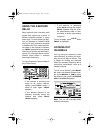
31
The birdie frequencies on this unit to watch for are:
To find the birdies in your scanner, begin by disconnecting the antenna and mov-
ing it away from the scanner. Make sure that no other nearby radio or TV sets
are turned on near the scanner. Use the search function and scan every frequen-
cy range from its lowest frequency to the highest. Occasionally, the searching will
stop as if it had found a signal, often without any sound. That is a birdie. Make a
list of all the birdies in your scanner for future reference.
GUIDE TO THE ACTION BANDS
United States Broadcast Bands
In the United States, there are several broadcast bands. The standard AM and
FM bands are probably the most well known. There are also four television audio
broadcast bands — the lower three transmit on the VHF band and the fourth
transmits on the UHF band.
Typical Band Usage
31.200 MHz 36.0500 MHz 114.400 MHz
116.0375 MHz 120.1625 MHz 128.1750 MHz
132.1755 MHz 140.1900 MHz 145.195 MHz
145.600 MHz 163.2200 MHz 813.400 MHz
823.800 MHz 940.900 MHz
HF Band
10-Meter Amateur Band 29.00–29.70 MHz
High Range 29.70–29.90 MHz
VHF Band
Low Range 30.00–50.00 MHz
6-Meter Amateur 50.00–54.00 MHz
Aircraft 108.00–136.00 MHz
U.S. Government 138.00–144.00 MHz
2-Meter Amateur 144.00–148.00 MHz
High Range 148.00–174.00 MHz
20-417.fm Page 31 Wednesday, August 4, 1999 11:33 AM


















